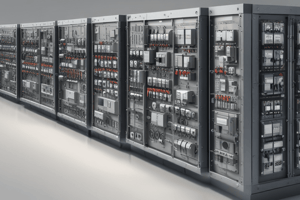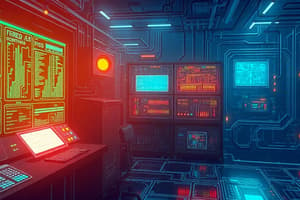Podcast
Questions and Answers
What is the primary purpose of a Programmable Logic Controller (PLC)?
What is the primary purpose of a Programmable Logic Controller (PLC)?
- To troubleshoot and diagnose issues
- To provide safety features for machinery
- To communicate with other PLCs and HMIs
- To control and monitor industrial equipment (correct)
What is the most commonly used PLC programming language?
What is the most commonly used PLC programming language?
- Ladder Logic (correct)
- Sequential Function Charts
- Structured Text
- Function Block Diagrams
What is the role of a PLC in a SCADA or HMI system?
What is the role of a PLC in a SCADA or HMI system?
- To troubleshoot and diagnose issues in the system
- To control and monitor industrial equipment
- To act as the physical interface between devices on the plant floor and the SCADA or HMI system (correct)
- To provide safety features for machinery
What are the three stages of a PLC's operation?
What are the three stages of a PLC's operation?
What is the difference between digital and analog I/O in a PLC?
What is the difference between digital and analog I/O in a PLC?
What is the importance of consulting the PLC manufacturer's documentation?
What is the importance of consulting the PLC manufacturer's documentation?
What are some resources available for learning PLC programming?
What are some resources available for learning PLC programming?
What is the benefit of using PLCs in industrial applications?
What is the benefit of using PLCs in industrial applications?
What is the primary role of a Programmable Logic Controller (PLC) in industrial automation?
What is the primary role of a Programmable Logic Controller (PLC) in industrial automation?
What type of input data is generated by a human operator using an HMI or SCADA system?
What type of input data is generated by a human operator using an HMI or SCADA system?
What is one of the key advantages of PLCs in industrial automation?
What is one of the key advantages of PLCs in industrial automation?
What feature of PLCs enables operators to monitor and analyze system performance?
What feature of PLCs enables operators to monitor and analyze system performance?
What is the primary function of HMIs in conjunction with PLCs?
What is the primary function of HMIs in conjunction with PLCs?
What is a benefit of process automation in various industries?
What is a benefit of process automation in various industries?
What do PLCs use to interface with sensors and actuators?
What do PLCs use to interface with sensors and actuators?
What is a feature of PLCs that ensures the safety of personnel and equipment?
What is a feature of PLCs that ensures the safety of personnel and equipment?
What is one of the primary benefits of automation in high-volume and repetitive tasks?
What is one of the primary benefits of automation in high-volume and repetitive tasks?
Which of the following is a key aspect of panel metering?
Which of the following is a key aspect of panel metering?
What is a significant advantage of automation in industries where precision is essential?
What is a significant advantage of automation in industries where precision is essential?
What is a key benefit of automation in terms of resource utilization?
What is a key benefit of automation in terms of resource utilization?
What is a key advantage of automation in terms of data accuracy and reporting?
What is a key advantage of automation in terms of data accuracy and reporting?
What is a key benefit of automation in industries involving hazardous tasks?
What is a key benefit of automation in industries involving hazardous tasks?
What is a key advantage of automation in terms of scalability?
What is a key advantage of automation in terms of scalability?
What is a key benefit of implementing process automation in terms of competitiveness?
What is a key benefit of implementing process automation in terms of competitiveness?
What is the primary function of a multifunction meter?
What is the primary function of a multifunction meter?
Which component of a SCADA system stores and archives data for analysis and reporting?
Which component of a SCADA system stores and archives data for analysis and reporting?
What is the primary benefit of using SCADA systems in distribution automation?
What is the primary benefit of using SCADA systems in distribution automation?
Which of the following is NOT a function of a SCADA system?
Which of the following is NOT a function of a SCADA system?
What is the role of a Panel Meter in distribution automation?
What is the role of a Panel Meter in distribution automation?
What is the primary function of an RTU in a SCADA system?
What is the primary function of an RTU in a SCADA system?
What is the benefit of integrating panel meters with SCADA systems?
What is the benefit of integrating panel meters with SCADA systems?
What is the role of a Historian in a SCADA system?
What is the role of a Historian in a SCADA system?
What is the primary function of a Programmable Logic Controller (PLC) in industrial automation?
What is the primary function of a Programmable Logic Controller (PLC) in industrial automation?
What type of programming language is Ladder Logic?
What type of programming language is Ladder Logic?
What is the purpose of the Memory component in a PLC?
What is the purpose of the Memory component in a PLC?
What represents inputs in Ladder Logic?
What represents inputs in Ladder Logic?
What is the purpose of Timers and Counters in PLCs?
What is the purpose of Timers and Counters in PLCs?
What type of I/O represents binary signals (0 or 1) for switches, sensors, and actuators?
What type of I/O represents binary signals (0 or 1) for switches, sensors, and actuators?
What is the continuous loop called in a PLC that involves reading inputs, executing the control program, and updating outputs?
What is the continuous loop called in a PLC that involves reading inputs, executing the control program, and updating outputs?
What is the purpose of the Output Modules in a PLC?
What is the purpose of the Output Modules in a PLC?
Flashcards are hidden until you start studying
Study Notes
Programmable Logic Controllers (PLCs)
- A PLC is a digital computer used in industrial automation and control systems.
- It is designed to perform real-time control functions, monitor inputs, and make decisions based on custom logic to control machinery and processes.
Components of a PLC
- Processor (CPU): Executes the control program.
- Input Modules: Receive signals from sensors or external devices and convert them into a digital format.
- Output Modules: Send control signals to actuators or external devices based on the PLC program's logic.
- Memory: Stores the PLC program and data, including RAM for temporary data storage and ROM for storing the control program.
PLC Programming Languages
- Ladder Logic: Resembles electrical relay logic diagrams, widely used for its visual representation of control logic.
- Structured Text: A high-level programming language similar to Pascal or C, used for complex algorithms and mathematical operations.
- Function Block Diagram (FBD): Uses graphical blocks to represent functions, making it suitable for complex systems.
Basic Programming Concepts
- Contacts and Coils: In ladder logic, contacts represent inputs, and coils represent outputs. A logical condition (contact) must be true for the output (coil) to be energized.
- Timers and Counters: PLCs often include timers and counters for controlling time-dependent and counting operations.
- Compare and Math Instructions: Used for comparing values or performing mathematical operations.
I/O Addressing
- Digital I/O: Represents binary signals (0 or 1) for switches, sensors, and actuators.
- Analog I/O: Deals with continuous signals, such as temperature or pressure, using analog-to-digital and digital-to-analog converters.
Scan Cycle
- PLCs operate in a continuous loop called a scan cycle, which involves reading inputs, executing the control program, and updating outputs.
Communication
- PLCs can communicate with other PLCs, human-machine interfaces (HMIs), and supervisory control and data acquisition (SCADA) systems.
Troubleshooting and Diagnostics
- Diagnosing and troubleshooting involve analyzing ladder logic, checking input and output status, and using diagnostic tools provided by the PLC manufacturer.
Applications
- PLCs are used in various industries, including manufacturing, automotive, energy, and more, to control processes such as conveyor systems, robotic arms, and manufacturing lines.
Safety Considerations
- Implementing safety features within the PLC program to ensure the safe operation of machinery.
PLC Programming Software
- Each PLC brand typically has its own programming software, such as Siemens Step 7, Allen-Bradley RS Logix, and Mitsubishi GX Works.
Learning Resources
- Documentation: Refer to the PLC manufacturer's documentation for specific details about the PLC model.
- Online Courses: Many online platforms offer courses on PLC programming for beginners.
- Hands-On Practice: Gain practical experience by working with PLCs in a lab environment.
Role of PLCs in Industrial Automation
- PLCs provide a reliable and flexible platform for controlling and monitoring various industrial processes and machinery.
- Key aspects of PLCs in automation include:
- Process Control
- Sequence Control
- Input/Output Handling
- Flexibility and Reconfigurability
- Reliability
- Fault Diagnosis and Recovery
- Communication and Networking
- Data Logging and Monitoring
- Safety Functions
Advantages of Automation
- Increased Efficiency
- Cost Savings
- Improved Accuracy and Consistency
- Enhanced Productivity
- 24/7 Operation
- Faster Response Time
- Improved Quality Control
- Better Resource Utilization
- Data Accuracy and Reporting
- Compliance and Traceability
- Reduced Downtime
- Safety Improvements
- Scalability
- Competitive Advantage
- Employee Satisfaction
Panel Metering and Introduction to SCADA System for Distribution Automation
- Panel metering involves the use of devices to monitor and display various electrical parameters within an electrical distribution system.
- Key aspects of panel metering include:
- Types of Panel Meters (Digital, Analog, Multifunction, and Smart Meters)
- Parameters Monitored (Voltage, Current, Power, Energy, and Power Factor)
- Monitoring and Control
- Integration with SCADA Systems
Introduction to SCADA System for Distribution Automation
- SCADA systems provide real-time monitoring, control, and automation capabilities for various processes within the distribution network.
- Components of SCADA System:
- RTUs (Remote Terminal Units)
- PLCs (Programmable Logic Controllers)
- Communication Infrastructure
- HMI (Human-Machine Interface)
- Historian
- Functions of SCADA in Distribution Automation:
- Real-time Monitoring
- Control and Automation
- Fault Detection and Diagnostics
- Load Management
- Data Logging and Reporting
- Benefits of SCADA in Distribution Automation:
- Improved Reliability
- Reduced Downtime
- Efficient Energy Distribution
- Remote Monitoring
- Data Analysis
Studying That Suits You
Use AI to generate personalized quizzes and flashcards to suit your learning preferences.





